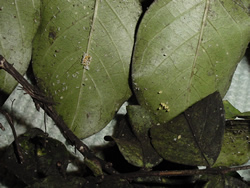| Question: Using a hose-end
sprayer, I've sprayed aphid-infested crape myrtles with
a combination of fish emulsion, compost tea, molasses, and
seaweed. I was told the fish emulsion would kill the aphids
and help dissipate the black soot and the other 3 components
would feed the plants. The aphids are gone, but the plants
look bad; they're still blackened, no new growth, a large
portion of the leaves are not green. Other large crape myrtles
nearby in the same lawn and watering area look very healthy.
Any suggestions to help these others back to recovery?
Answer: The damage
that aphids do to the leaves on a crape myrtle is not reversible.
Those leaves will remain deformed until they are
eventually shed. Normally the tree will grow through the
problem with new growth that is not affected. I cannot attest
to the efficacy of the material you used to treat the problem.
The black sooty substance (mold growing on the excretion
of the aphids as shown on the bottom right foliage in the
image) will sometimes wash off the leaves and sometimes
will remain until the tree sheds those leaves. Your tree
should be fine
next year. Give it an early spring application of fertilizer
(that used on the lawn should be fine) and watch for the
aphids. Treat them as soon
as you see them with a pesticide that is labeled for killing
them. The small colonies seen on the bottoms (green surface
with no black sooty mold) are eggs of beneficial insects
which will feed on the aphids. The white pieces of material
are aphid skins. Aphids can be seen as the small, translucent
individuals---the most apparent are the aphids near the
stem with black sooty mold on the center, left side of the
image--you can see their heads and legs.
|






